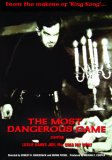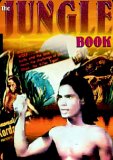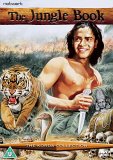![She Wore a Yellow Ribbon (John Wayne) [1949]](/pictures/1041620.jpg) She Wore a Yellow Ribbon (John Wayne) | DVD | (05/06/2006)
from £14.47
| Saving you £-4.48 (N/A%)
| RRP
She Wore a Yellow Ribbon (John Wayne) | DVD | (05/06/2006)
from £14.47
| Saving you £-4.48 (N/A%)
| RRP Dutiful cavalry officer Nathan Brittles (John Wayne) is reluctant to retire in the face of an imminent Native American uprising. His last official task is to escort the commander's wife and her niece to the Sudrow's Wells stagecoach stop but it proves to be a journey fraught with danger. This film the second in John Ford's cavalry trilogy is a masterpiece of the cinema and is acclaimed as one of the greatest Westerns ever made.
![King Kong [1933]](/pictures/1035437.jpg) King Kong | DVD | (01/10/2012)
from £13.05
| Saving you £-3.06 (N/A%)
| RRP
King Kong | DVD | (01/10/2012)
from £13.05
| Saving you £-3.06 (N/A%)
| RRP A daring expedition happens across a giant ape in this classic 1933 creature feature.
![King Kong - The Eighth Wonder Of The World [1933]](/pictures/1013196.jpg) King Kong - The Eighth Wonder Of The World | DVD | (15/01/2001)
from £13.09
| Saving you £-3.10 (N/A%)
| RRP
King Kong - The Eighth Wonder Of The World | DVD | (15/01/2001)
from £13.09
| Saving you £-3.10 (N/A%)
| RRP Now you see it. You're amazed. You can't believe it. Your eyes open wider. It's horrible, but you can't look away. There's no chance for you. No escape. You're helpless, helpless. There's just one chance, if you can scream. Throw your arms across your eyes and scream, scream for your life!" And scream Fay Wray does most famously in this monster classic, one of the greatest adventure films of all time, which even in an era of computer-generated wizardry remains a marvel of stop-motion animation. Robert Armstrong stars as famed adventurer Carl Denham, who is leading a "crazy voyage" to a mysterious, uncharted island to photograph "something monstrous ... neither beast nor man". Also aboard is waif Ann Darrow (Fay Wray) and Bruce Cabot as big lug John Driscoll, the ship's first mate. King Kong's first half-hour is steady going, with engagingly corny dialogue ("Some big, hard-boiled egg gets a look at a pretty face and bang, he cracks up and goes sappy") and ominous portent that sets the stage for the horror to come. Once our heroes reach Skull Island, the movie comes to roaring, chest-thumping, T-rex-slamming, snake-throttling, pterodactyl-tearing, native-stomping life. King Kong was ranked by the American Film Institute as among the 50 best films of the century. Kong making his last stand atop the Empire State Building is one of the film's most indelible and iconic images. --Donald Liebenson, Amazon.comOn the DVD: Although a little light on extras, this is happily the Director's Cut, restoring scenes that were censored after the film's original 1933 run, including Kong peeling off Fay Wray's clothes like a banana, and our hirsute hero using unfortunate natives as dental floss. The ratio of 4:3 is correct for a film of this age; the picture and (mono) sound are perfectly acceptable without being revelatory. The 25-minute "making of" documentary from 1992 is a 60th anniversary tribute to the film, which details all of Kong's many ground-breaking contributions to cinema, from Willis O'Brien's use of stop-motion and rear projection effects to Max Steiner's music score. There are contributions from film historians, modern admirers of the film including composer Jerry Goldsmith--who admits that Steiner created a template that Hollywood composers are still following--and a few surviving participants such as sound effects man Murray Spivak. Apparently, director Merian C. Cooper's original idea was to capture live gorillas, transport them to the island of Komodo and film them fighting the giant lizards! Thanks to Willis O'Brien's pioneering effects work good sense prevailed and a cinema classic was born. --Mark Walker
![King Kong [DVD] [2017]](/pictures/1142825.jpg) King Kong | DVD | (17/04/2019)
from £8.45
| Saving you £N/A (N/A%)
| RRP
King Kong | DVD | (17/04/2019)
from £8.45
| Saving you £N/A (N/A%)
| RRP "Now you see it. You're amazed. You can't believe it. Your eyes open wider. It's horrible, but you can't look away. There's no chance for you. No escape. You're helpless, helpless. There's just one chance, if you can scream. Throw your arms across your eyes and scream, scream for your life!" And scream Fay Wray does most famously in this monster classic, one of the greatest adventure films of all time, which even in an era of computer-generated wizardry remains a marvel of stop-motion animation. Robert Armstrong stars as famed adventurer Carl Denham, who is leading a "crazy voyage" to a mysterious, uncharted island to photograph "something monstrous ... neither beast nor man." Also aboard is waif Ann Darrow (Fay Wray) and Bruce Cabot as big lug John Driscoll, the ship's first mate. King Kong's first half-hour is steady going, with engagingly corny dialogue ("Some big, hard-boiled egg gets a look at a pretty face and bang, he cracks up and goes sappy") and ominous portent that sets the stage for the horror to come. Once our heroes reach Skull Island, the movie comes to roaring, chest-thumping, T. rex-slamming, snake-throttling, pterodactyl-tearing, native-stomping life. King Kong was ranked by the American Film Institute as among the 50 best films of the 20th century. Kong making his last stand atop the Empire State Building is one of the movies' most indelible and iconic images. --Donald Liebenson
 Mummy, The / Creature From The Black Lagoon | DVD | (18/10/2004)
from £12.99
| Saving you £-3.00 (N/A%)
| RRP
Mummy, The / Creature From The Black Lagoon | DVD | (18/10/2004)
from £12.99
| Saving you £-3.00 (N/A%)
| RRP The Mummy: Boris Karloff's legendary performance has become a landmark in the annals of screen history. As the mummy Im-Ho-Tep he is accidentally revived after 3 700 years. Alive again he sets out to find his lost love. Today over 70 years after it was first released it still remains as compelling as ever! Creature From The Black Lagoon: Scientists drug and capture the terrifying creature who subsequently becomes enamoured with the head scientist's female assist
![The Mummy [1932]](/pictures/1012698.jpg) The Mummy | DVD | (31/10/2005)
from £4.18
| Saving you £5.81 (139.00%)
| RRP
The Mummy | DVD | (31/10/2005)
from £4.18
| Saving you £5.81 (139.00%)
| RRP Boris Karloff's legendary performance has become a landmark in the annals of screen history. As The Mummy Im-Ho-Tep he is accidentally revived after 3 700 years by a team of British archaeologists. It is revealed in a flashback that he was a high priest embalmed alive for trying to revive the vestal virgin whom he loved after she had been sacrificed. Alive again he sets out to find his lost love. Today over 50 years after The Mummy was first released this brooding dream-like film remains a masterpiece not only of the genre but for all time.
![She Wore A Yellow Ribbon [1950]](/pictures/1004033.jpg) She Wore A Yellow Ribbon | DVD | (30/04/2001)
from £13.10
| Saving you £-3.11 (N/A%)
| RRP
She Wore A Yellow Ribbon | DVD | (30/04/2001)
from £13.10
| Saving you £-3.11 (N/A%)
| RRP The second instalment of John Ford's famous cavalry trilogy, this meditative Western continues the director's fascination with history's obliteration of the past. It features one of John Wayne's more sensitive performances as Capt. Nathan Brittles, a stern yet sentimental war horse who has difficulty preparing for his impending military retirement. All things considered, he refuses to leave before fulfilling his obligation to the local Indian tribe. It's a film about honour and duty as well as loneliness and mortality. And Oscar-winner Winton C. Hoch beautifully photographs it in Remington-like Technicolor tones (you've never seen such stunning cloud-covered skies). The combination of melancholy and farce (Victor McLaglen makes a perfect court jester) evokes comparisons to Shakespeare. Best of all, the scene in which Wayne fights back tears when receiving a gold watch from his troops is unforgettably bittersweet. If you view the whole trilogy, it actually makes sense to save this for last. --Bill Desowitz, Amazon.com
![The Most Dangerous Game (Digitally remastered in colour) [DVD] [1932]](/pictures/1109063.jpg) The Most Dangerous Game (Digitally remastered in colour) | DVD | (07/09/2009)
from £26.96
| Saving you £-18.97 (N/A%)
| RRP
The Most Dangerous Game (Digitally remastered in colour) | DVD | (07/09/2009)
from £26.96
| Saving you £-18.97 (N/A%)
| RRP  The Most Dangerous Game | DVD | (10/07/2006)
from £N/A
| Saving you £N/A (N/A%)
| RRP
The Most Dangerous Game | DVD | (10/07/2006)
from £N/A
| Saving you £N/A (N/A%)
| RRP The Most Dangerous Game
![The Thief Of Bagdad [1925]](/pictures/1003495.jpg) The Thief Of Bagdad | DVD | (25/02/2002)
from £N/A
| Saving you £N/A (N/A%)
| RRP
The Thief Of Bagdad | DVD | (25/02/2002)
from £N/A
| Saving you £N/A (N/A%)
| RRP Dating from 1924 this Thief of Bagdad is justifiably billed here as "one of the truly great silent films of the 1920s." As the forerunner of generations of magical, effect-laden fantasy epics, its importance is practically immeasurable. And still, after eight decades, it has startling, thrilling qualities which the finest computer graphics would struggle to surpass. Douglas Fairbanks, co-founder of United Artists, is the eponymous hero, swindling, fighting and leaping his way to true love through a series of adventures which take him from a magnificently surreal Bagdad to enchanted forests, ocean bottoms and magic carpet rides. "Happiness must be earned," is the motto; Fairbanks and his director Raoul Walsh certainly don't short-change their audience in bringing it to life. The effects are stunning, with a particularly gruesome slaying of a monster. Every scene is crammed with detail and incident. Fairbanks is a whirlwind of muscular, balletic flamboyance. And while his princess (Julanne Johnson) is a stereotype of vapidity, there's gleamingly malevolent support from Anna May Wong as the evil Mongol Slave Girl. Over two hours of sheer enjoyment belie the notion that cinematic sophistication is a modern achievement. On the DVD: The Thief of Bagdad disc presents the restored and remastered print (the tints have a luminous quality) complete with a 1975 score by master organist Gaylord Carter--you can almost feel the Wurlitzer rising from the pit of your entertainment centre. The audio essay, written by film historian R Dixon Smith, is an invaluable extra, providing essential information on how the picture was made and how the art designers played with proportion to create many of the visual tricks and a fantastical atmosphere. --Piers Ford
 The Jungle Book | DVD | (27/02/2006)
from £12.99
| Saving you £-3.00 (N/A%)
| RRP
The Jungle Book | DVD | (27/02/2006)
from £12.99
| Saving you £-3.00 (N/A%)
| RRP Join Mowgli, Baloo the Bear and friends in the classic Disney adaptation of Rudyard Kipling's children's novel
![The Most Dangerous Game [DVD]](/pictures/1096111.jpg) The Most Dangerous Game | DVD | (07/09/2009)
from £N/A
| Saving you £N/A (N/A%)
| RRP
The Most Dangerous Game | DVD | (07/09/2009)
from £N/A
| Saving you £N/A (N/A%)
| RRP The Most Dangerous Game
![The Thief Of Bagdad [1924]](/pictures/1001618.jpg) The Thief Of Bagdad | DVD | (26/04/2004)
from £6.98
| Saving you £12.00 (240.48%)
| RRP
The Thief Of Bagdad | DVD | (26/04/2004)
from £6.98
| Saving you £12.00 (240.48%)
| RRP Fantasy adventure made in the 1920's and is just as entertaining in the 21st century. Ahmed the thief takes anything he wants until he meets the Princess. So besotted does he become that he is prepared to make himself worthy of her outrivalling even the challenge of the Mongol Prince. He has a variety of adventures with fantastic special effects.
 Jungle Book | DVD | (26/06/2006)
from £12.98
| Saving you £-1.00 (N/A%)
| RRP
Jungle Book | DVD | (26/06/2006)
from £12.98
| Saving you £-1.00 (N/A%)
| RRP Striking cinematography and outstanding special effects make this multiple Oscar-nominated adaptation of Rudyard Kipling's children's story an unforgettable visual feast. Lost in the jungle as a baby and brought up by a wolf pack Mowgli lives a carefree life in the jungle with his animal friends not knowing anything of his past until one day he stumbles upon a village full of people. Captured by frightened villagers he is taught about the man's world and befriends a young girl

Please wait. Loading...
This site uses cookies.
More details in our privacy policy